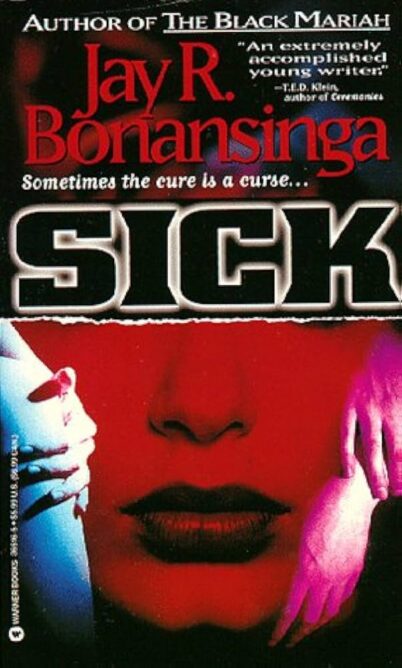By JAY R. BONANSINGA (Warner Books; 1995)
The second novel by Jay Bonansinga, 1995’s SICK came and went with nary a ripple, despite some positive reviews and a tantalizing premise. The problem? 1995 was possibly the worst time in history for a horror paperback to debut, as the horror boom of the previous two decades was in its death throes (Bonansinga’s debut novel THE BLACK MARIAH appeared the previous year to a similar response, and was further hobbled by the fact that its narrative, about a trucker who due to a curse is unable to stop driving, was distractingly similar to that of a certain hit film released the same year).
SICK exhibits the evolve-or-die gist that overtook the horror industry in the boom’s final years, with a narrative that strains hard—too hard—for originality. You may recall 1989’s overwrought THE AXEMAN COMETH by John Farris, which juxtaposed stream-of-consciousness storytelling with a spectral serial killer and the ghost of Ernest Hemingway, and SICK is similarly oriented.
It at least has a (mostly) coherent narrative, concerning Sarah, a Chicago based stripper with a horrific past (we don’t learn how horrific until the final pages) who after suffering debilitating migraines learns she has a box-shaped shaped brain tumor. This is significant because years earlier Sarah was treated by Henry, a dashing shrink who encouraged her to visualize a receptacle in which all the pain and anger of her upbringing was enclosed–an enclosure much like the shape of the tumor. Henry’s subsequent administrations lead to another visualization, this time of the tumor being obliterated; the visualization is successful, leading to the disappearance of the tumor, but it results in odd physical effects that include swelling tattoos.
It’s at this point that things get wonky, with Sarah (for reasons that are never made entirely clear) becoming possessed by the spirit of Harry Houdini(!). The latter of course uses his rebirth to embark on a killing rampage, giving the proceedings a very DARK HALF-ish feel, with some overworked cops added to the mix.
To be sure, Jay Bonansinga gets many things right. His heroine is well characterized and avoids the issues that tend to dog women personages created by male authors (and vice-versa), meaning Sarah isn’t excessively vulnerable nor impossibly manly, and that the inevitable romance she has with Henry is related with a minimum of sap. The gory content, combined with the grittiness of the windy city settings (and a very graphically described rape), breaches splatterpunk territory, and does so with winsome flair.
Less edifying are the slip-streamy passages, denoted by copious dreams and hallucinations (presented more often not in italicized text). Hallucinatory prose clearly wasn’t Bonansinga’s forte and, combined with the fact that the narrative feels like two separate stories mashed together, keeps an otherwise accomplished book from achieving greatness.

